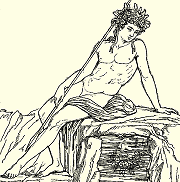|
性行为的发展 |
|
性行为的发展阶段:
青春期的发展 |
|
性欲行为的发展: 历史回顾 |
|
直到19世纪中叶,西方国家中产阶级家庭的青少年发现他们自己处处既受到保护也受到压制。他们一直都在忙于准备“真正的生活”:延长的学习(时间)和没完没了地为永远更特殊的成人的工作做着各种准备,不再有(从前)被允许的性娱乐(sensual
distraction)了。从那时起,就像被定义的那样,青少年们即使成长到青春期也是“不成熟的”。他们还被要求直到结婚之前保持性节欲,但是直到新郎积攒足够的钱、并因此能够“养活一个家庭”之前,婚姻通常是不可能的事情。
可是,与此同时,就像所有伟大的文明所记载和所公布的那样,受过教育的成年人仍旧清醒地意识到年轻人的性欲潜力。的确,在西方艺术和文学里许多著名的恋人都是青少年:伊洛斯与普绪客(Eros
and Psyche)、皮拉摩斯与提斯柏(Pyramus
and Thisbe)、特洛伊罗斯与克雷西达(Troilus
and Cressida)、达佛涅斯与克洛伊(Daphnis
and Chloe)、弗鲁瓦和布朗歇弗洛(Floire
and Blancheflor)、奥卡森与尼科莱特(Aucassin
and Nicolette)和罗密欧与朱丽叶(Romeo
and Juliet)。年轻的男女通常也被描写成拒绝情欲的人:当海伦离开他的丈夫墨奈劳斯(Menelaos)并跟随帕里司(Paris)到特洛伊时,她只有12岁。当“许多少年和少女目睹了那喀索斯(Narcissus)的爱人”的时候,他当时也只有16岁。当宙斯(Zeus)成功使盖尼米得(Ganymede)
成为“自己的意中人”的时候,盖尼米得甚至更为年轻;当阿波罗(Apollo)和西风(Zephyrus)在为自己的地盘争夺的时候,雅辛托斯(Hyacinthus)还是一位英俊少年;海勒斯(Hylas)也如此,当赫拉克勒斯(Hercules)把他从父母身边诱拐走时,他还是少年。我们同样在著名的歌剧里会找到痴情少年的事例:在莫扎特的《费加罗的婚礼》里,痴情少年凯鲁比诺(Cherubino)约15岁;在理查德·施特劳斯的歌剧《玫瑰骑士》(Der
Rosenkavalier)里,奥克达菲安(Octavian)是17岁,而且是年长的已婚女人的恋人[1]。
最后,要继续列举这种在“高度文明”和中产阶级的道德之间的相互矛盾的现象让人感到尴尬。尤其到了青年人反对他们父辈的(道德)“虚伪”之时,到了20世纪的下半叶,多数西方国家对青少年的性欲行为(erotic
behavior),采取了一种更为现实和更为宽容的态度。
|
|
 |
|
 |
 |
|
19世纪著名爱情故事举例
(从左自右):伊洛斯与普绪客、那喀索斯、盖尼米得、阿波罗与雅辛托斯和罗密欧与朱丽叶。图片来源:FCIT,
http://etc.usf.edu/clipart
19th- century illustrations of famous love stories
(from the left): Eros and Psyche, Narcissus, Ganymede, Apollo and Hyacinthus, Romeo and Juliet.
Source: FCIT,
http://etc.usf.edu/clipart
|
|
|
|
Development of Sexual Behavior |
|
Stages of Development: Adolescence |
|
Erotic Behavior: Historical Introduction |
|
By the middle of the 19th century, middle-class adolescents in Western countries found themselves both protected and pressured from all sides. They were kept busy preparing for “real life”: Extended study and an ever longer preparation for ever more specialized adult work no longer permitted sensual distractions. Young people now were, by definition, “immature”, even after puberty. They were also expected to remain sexually abstinent until marriage, but marriage was often impossible until the bridegroom had earned enough money and thus could “afford to support a family”.
At the same time, however, educated adults remained well aware of the erotic potential of the young as described and celebrated in all great civilizations. Indeed,
many of the famous lovers in Western art and literature are adolescents: Eros and Psyche, Pyramus and Thisbe, Troilus and Cressida, Daphnis and Chloe, Floire and Blancheflor, Aucassin and Nicolette, Romeo and Juliet. Young females and males were also often depicted as objects of passion: Helen was only 12 years old when she left her husband Menelaos and followed Paris to Troy. Narcissus was 16 when “many youths and maidens sought his love”. Ganymede was even younger when Zeus made him his favorite, Hyacinthus was an adolescent when Apollo and Zephyrus quarreled over his possession, and so was Hylas when Hercules abducted him from his parents. We also find examples of amorous teenagers in famous operas: The love-obsessed Cherubino in Mozart’s “Marriage of Figaro” is about 15 years old; Octavian in Richard Strauss’ “Rosenkavalier” is 17 and the lover of an older married woman.
Eventually, the contradiction between “high culture” and middle class morality became too embarrassing to continue.
Especially the young rebelled against the “hypocrisy” of their elders, and in the second half of the 20th century most Western countries adopted a more realistic and permissive attitude toward adolescent erotic behavior.
|